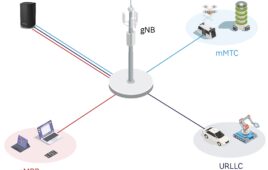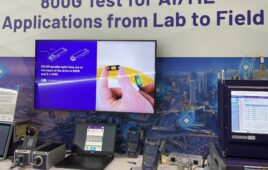Millimeter-wave signals used in 5G networks provide wide bandwidth and high data rates. Signal losses, both over the air and through interconnects, bring design challenges.
Millimeter wave (mmWave) signals offer engineers countless application possibilities, including ranging, object detection, and mapping. Unfortunately, mmWaves bring numerous design challenges. Not only do mmWave signals cover short ranges, but they can suffer from losses as they travel through cables, connectors, and PCB traces. You can, however, minimize losses through solid design practices.
mmWave refers to RF signals with wavelengths typically between 1 mm and 10 mm, covering frequencies from roughly 30 GHz to 300 GHz (Figure 1). In terms of 5G, mmWave starts at 24 GHz. This band of frequencies is often referred to as Extremely High Frequency (EHF), with Super High Frequency (SHF) being below EHF and Tremendously High Frequency (THF) above it.
At mmWave frequencies, signals lose strength from absorption in the atmosphere, which limits their travel distance. This absorption results from the presence of oxygen in the atmosphere, both in elemental form and in water vapor. While such signal degradation is often a drawback in many radio systems, it is surprisingly useful for high-bandwidth networks.
By preventing signals from traveling too far, you can reuse the same frequencies in other nearby networks without interference. The higher frequency of mmWave compared to Wi-Fi also allows for far more bandwidth, which is one of the many reasons why 5G networks utilize mmWave.
The wide bandwidth of mmWave leaves plenty of room for expansion, meaning that mmWave is unlikely to become congested for the foreseeable future. The high frequency also means that equipment can use small antennas, making them easy to integrate into small devices. This small size also makes the construction of small-scale phased array antennas feasible.
Phased arrays make beamforming possible, which lets multiple devices share the same frequency without interfering with each other. mmWave systems (especially 5G) can handle thousands of devices simultaneously while ensuring that each device can take full advantage of the bandwidths offered by the higher frequencies.
Unlike signals at lower frequencies, mmWave is extremely directional, operating more like a laser beam than a wave that diverges drastically from its source. This means that mmWave applications operate more on a line-of-sight basis, thereby reducing interference between different mmWave devices.
What challenges does mmWave introduce?
You might think that mmWave’s high bandwidth capabilities, lack of interference, and directional nature make it the ideal frequency range for any communication network. That’s not necessarily the case.
High attenuation from the atmosphere often limits transmission distances to just 100 m, though experiments have reached distances of 10 km under the right conditions. In the case of 5G networks, the high attenuation, and resulting short range requires numerous 5G cells near users, which significantly increases the cost of building and maintaining a reliable network.
Of course, this would apply to any mmWave network, including those used in consumer, commercial, and industrial environments. This is why other network technologies utilizing lower frequencies such as 2.4 GHz and 5 GHz Wi-Fi are often preferred.
The high frequencies associated with mmWave can push traditional semiconductors to their limits. For example, circuits utilizing traditional silicon can’t go beyond 190 GHz, making the entire frequency range above 190 GHz inaccessible. That’s why other processes, such as GaN, come into use.
PCB traces
When operating at mmWave frequencies, PCB traces become more complicated because of signal degradation. Furthermore, PCBs also introduce numerous challenges in their design, including interference from other circuits, the choice of dielectric, subtle variations in identical PCBs, and even environmental conditions of the day. (For example, the direction of cleaning copper clad layers during manufacture can change the signal integrity performance of a trace).
Furthermore, trying to get mmWave frequencies to travel through a PCB can also challenge you because signals can radiate from the tail ends of vias that are not fully connected. The change in material from trace to via can also induce losses and reflections, which are only more problematic in connectors. This is especially true for connectors that utilize mating contacts where the contact point between two connectors isn’t at the ends of the contacts.
If long cable lengths carry mmWave signals, then the exact length of that cable assembly will determine the signal degradation; mismatched lengths and impendences will result in reflections. At low frequencies, slight mismatches are not massively degrading, but when dealing with mmWave, even the smallest mismatch can destroy signal fidelity.
What can you do?
You can follow numerous steps to solve the numerous challenges that mmWave frequencies bring. Unfortunately, you can’t skip any of these steps.
First, any connector, cable, or PCB trace intended to carry mmWave signals needs construction that uses high-grade materials to minimize signal loss. Furthermore, they should also be rated for the expected frequency ranges.
To minimize signal losses, connectors should make full contact along the entire conductor. All conductors need termination. Connectors often use a cage whereby a socket connector can grab and fully enclose a plug connector from the tip to the base. Figure 2 shows examples of such connectors.
For designs that require PCB traces, you must ensure that traces avoid turns and vias. If you must use vias, then you must terminate the end of the via with a trace. Unconnected vias not only act as reflection points; they can also radiate signals, which introduces EMI issues.
Any mmWave communication between two boards takes place through coax cables or flyover cables, but the length of the cable should carefully match the wavelength of the intended signal.
Cables and connectors
Engineers have numerous options from many companies for connecting mmWave systems, such as quick-connect connectors. These assemblies utilize high-quality dielectrics and conductor materials and are manufactured to specific sizes and lengths to reduce signal reflections. These are commonly used in high-volume manufacturing due to the reduced mating/de-matting time and the availability of ganged connectors.
Such assemblies are often already terminated, which simplifies the installation of mmWave cabling. For applications that have specific requirements, many manufacturers also offer custom cable assemblies that provide phase matching or can operate in extreme environments.
The choice of connector mounting is also essential in any mmWave design. Angled connectors (30° and 45° with respect to PCB) are ideal for use for a wide range of frequencies (up to 26.5 GHz). Angled connectors (Figure 3), available from numerous manufacturers, provide strain relief to cables (essential in mmWave applications) and improve voltage standing wave ratio (VSWR) ratings (up to 1.30) compared to vertical (90°) mount connectors.
Some mmWave systems can experience shock and vibration. For these applications, SMP3 coax connectors can help engineers thanks to their 30% smaller design compared to SMPM and a floating bullet. With a maximum frequency of 67 GHz and a VSWR of 1.50, these connectors offer engineers options for mmWave applications in harsh environments.
Conclusion
mmWave’s high frequency, large bandwidth, line-of-sight behavior, and easy manipulation through miniature phased arrays can provide wireless devices with high data rates. For all the benefits that it provides, it also faces numerous challenges if not properly addressed. Thus, you must understand the design constraints that mmWave presents, use best RF practices when designing PCBs, and carefully choose connectors made from high-quality brass, beryllium copper, or stainless steel to ensure ruggedness and high performance.








Tell Us What You Think!